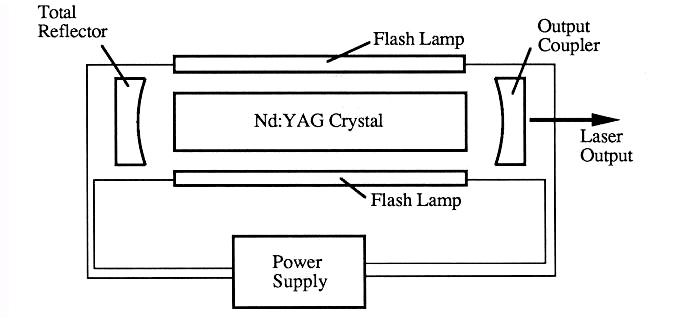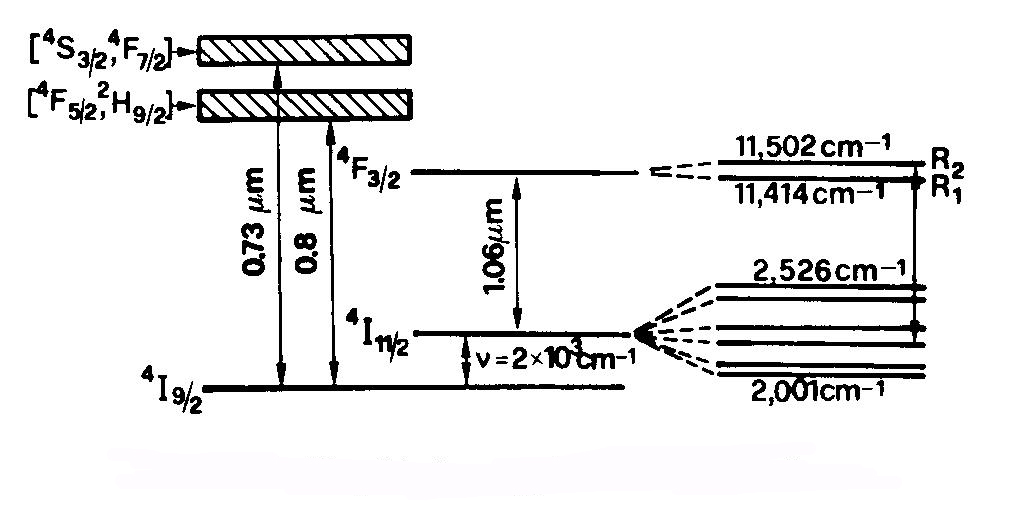Level 1
Section 5.7: YAG laser machining of materials
FUNDAMENTALS:
ND:YAG laser is one of Solid State Lasers. Solid lasers use ions suspended in a crystalline matrix to produce laser light. The ions or dopants provide the electrons for excitation, while the crystalline matrix propagates the energy between ions. The two main classes of dopants in the laser medium are Chromium (Cr3+) for ruby lasers and Neodinium (Nd3+) for ND:YAG and ND:glass lasers. The ND:YAG and Nd:glass lasers are in general very similar to each other in structure and lasing action. Excitation is achieved by krypton or xenon flash lamps, and an output wavelength of 1.06gm in the near infrared region of the spectrum is obtained. The Nd:glass laser uses a glass host material for the neodymium ions. The glass rods have the advantage that they can be grown to larger sizes more economically than the YAG crystals, but glass has a lower thermal conductivity which limits the pulsed operation of the Nd:glass laser. Therefore, Nd:glass lasers are used in applications which require low pulse repetition rates and high pulse energies (up to 100 Joules per pulse). In general, the pulse operation of the neodymium lasers make them desirable for hole piercing and deep keyhole welding applications.
The host material in ND:YAG lasers is a complex crystal of Yttriurn-Aluminum-Garnet (YAG) with the chemical composition Y3AI5O12. Fig --- shows the schematic of a Nd:YAG Laser. The YAG crystal has a relatively high thermal conductivity, which improves thermal dissipation in the laser cavity, so continuous wave operation up to a few hundred Watts is possible. When operated in a pulsed mode, high pulsing rates can be achieved, and average powers of up to 1 kW are available. The actual lasant is the Nd+3 ions which have been doped into a YAG crystal. The YAG crystal is transparent and colorless. When doped with approximately 1% Nd, the crystal takes on a light blue color.

Fig---: Schematic of Nd:YAG Laser
Figure -- shows a simplified energy level scheme for ND:YAG. These levels arise from the three inner-shell 4f electrons of the Nd3+ ion, which are effectively screened by eight outer electrons (5S2 and 5 P6). The crystal field of YAG only weakly influences energy levels, so the Russell-Saunders coupling scheme of atomic physics can be used. Level notation is accordingly based on this scheme, and the symbol characterizing each level has the form 2S+1LJ where S is the total spin quantum number, J is the total angular momentum quantum number, and L is the orbital quantum number. The 4I9/2 ground level correspond to a state in which 2S+1= 4 (i.e., S = 3/2), L = 6, and J = L-S = 9/2. Each level is (2J + 1)-fold degenerate corresponding to the quantum number mj running from -J to + J in unit steps. Note that, since the degeneracy of all sublevels is always the same (i.e., g = 2), we can disregard this degeneracy and consider each sublevel in Fig--- as if it were a single nondegenerate level.

Fig---: Simplified energy levels of Nd:YAG
Generally, a cooling system is required for operation of ND:YAG lasers. With an efficiency of about 3%, a typical ND:YAG produces thirty times as much waste heat as laser output; this heat must be removed in order to ensure proper laser operation. Flooding the optical compartment with water can remove waste heat; however, the water absorbs a significant amount of the flashlamp energy, and the turbulence of the water can produce optical distortion and imaging problems. These problems can be overcome by flowing water over the outside of the optical cavity and by encasing the lasing rod and flashlamp with transparent cooling jackets. Furthermore, the flashlamp electrode assemblies should be cooled to prevent thermal loading, and deionized water should be used to prevent any electrical conduction through the water.
The, output characteristics of a ND:YAG laser can be altered by varying the pumping discharge waveform. For high pulse energy in a pulse time of one millisecond, a long lamp pulse is used to obtain a six to seven Joule pulse composed of many spiked oscillations within the pulse. Such a laser can operate at several hundred cycles per second and is useful in laser cuttings. Laser beam pulse frequency and shape can be tailored by using Q switching, where a shutter moves rapidly in and out of the path of the beam. In this manner, beam output is interrupted until a high level of population inversion and energy storage is achieved in the resonator. If the optical cavity is switched from no reflections (low Q) to near total reflection (high Q), the cycle can be optimized to build up the maximum population inversion before the pulse is generated (switched from low to high Q). This results in a beam pulse with a high energy (up to one joule) and a short pulse period (down to 10 ns), which is especially useful for deep hole drilling applications.
APPLICATIONS:
ND:YAG lasers are widely used in a variety of applications, including: